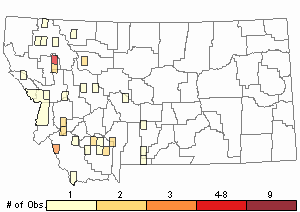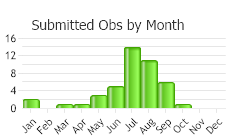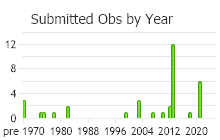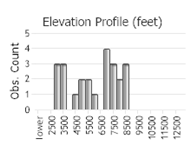View in other NatureServe Network Field Guides
NatureServe
Montana
Utah
Wyoming
Idaho
Wisconsin
British Columbia
South Carolina
Yukon
California
New York
A Plagiomnium Moss - Plagiomnium ellipticum
Other Names:
Plagiomnium rugicum
General Description
Plants: Acrocarpous, growing in open tufts (Crum and Anderson et al. 1981) and mats, green or green with yellow tones. Fertile stems upright, 20-50 mm tall, not tree-like; infertile stems sometimes reaching 120 mm, growing at an oblique angle or bowing; rhizoids brown (FNA 2014).
Leaves: Smaller and more distant below (Crum and Anderson et al. 1981), wavy and twisted, bent or curved when dry, plane and spreading to about 45 degrees when damp, 1-8 mm in length, widely elliptic, egg-shaped, or nearly circular, narrowing to a widely curved leaf tip, or tip sometimes squared or slightly notched, with a slender, oblique mucro or cusp that is seldom dentate; base not extending down the stem or seldom slightly so; margins flat, slightly dentate above or to over half the leaf length but seldom close to the bottom, on infertile stems the margins frequently smooth; costa reaching or exceeding the leaf tip (FNA 2014).
Leaf Cells: Marginal teeth usually 1-celled; cells at the leaf edge arranged in 1 layer, short and narrow to diamond-shaped, in bigger leaves occasionally longer, in 2-4 series; medial laminal cells with length about the same as or a little longer than the width, the cells becoming noticeably smaller near the margins, occurring in up-and-down rows or somewhat obliquely-rowed, usually porose but sometimes faintly so, the angles usually not or only slightly thickened, but seldom strongly so (FNA 2014).
Phenology
Fruit ripens in the last part of spring (FNA 2014).
Diagnostic Characteristics
Frequently grows on organic soil of wetlands, developing extensive mats (FNA 2014).
The similar Plagiomnium rostratum is smaller and has shorter, nonporose laminal cells (FNA 2014).
The variation of characters within and among populations of Plagiomnium makes identification difficult without fertile plants (FNA 2014).
Range Comments
North American Range
Canada: YT and NT, BC to NL (except NB, NS and PE); USA: AK, from CA to NE and north from there (except WA, ID and NV), also TX, OK, LA and MO, MN, WI, MI, PA, NY, and ME (FNA 2014). Known in Montana from Carbon, Flathead, Gallatin, Glacier, Lake, Lewis and Clark, Madison, Meagher, Mineral, Missoula, Park, Ravalli, Sanders, Silver Bow, Sweet Grass, and Teton Counties (Elliott and Pipp 2016).
Observations in Montana Natural Heritage Program Database
Number of Observations: 48
(Click on the following maps and charts to see full sized version)
Map Help and Descriptions
Relative Density

Recency



 (Observations spanning multiple months or years are excluded from time charts)
(Observations spanning multiple months or years are excluded from time charts)
Habitat
Moist soil and humus (Elliott and Pipp 2016) or peat, found along watercourses and lake margins, wetlands (FNA 2014) that are often high in nutrients, wooded swamps, shrubby willows by streams (Crum and Anderson et al. 1981). Occurring at low altitudes (FNA 2014).
Reproductive Characteristics
Dioicous. Seta 1-3 per perichaetium, 18-45 mm tall. Capsule 3-5 mm in length, drooping, with an obscure neck (FNA 2014).
Stewardship Responsibility
References
- Literature Cited AboveLegend:
 View Online Publication
View Online Publication Crum, H.A. and L.E. Anderson. 1981. Mosses of Eastern North America. 2 volumes. Columbia University Press, New York. 1328 pp.
Crum, H.A. and L.E. Anderson. 1981. Mosses of Eastern North America. 2 volumes. Columbia University Press, New York. 1328 pp. Elliott, J.C. and A.K. Pipp. 2018. A Checklist of Montana Mosses (1880-2018). Updated 3 January, 2020. Montana Natural Heritage Program, Helena, Montana. 73 pp.
Elliott, J.C. and A.K. Pipp. 2018. A Checklist of Montana Mosses (1880-2018). Updated 3 January, 2020. Montana Natural Heritage Program, Helena, Montana. 73 pp. Flora of North America Editorial Committee, eds. 2014. Flora of North America North of Mexico. Volume 28. Bryophytes: Mosses, Part 2. Oxford University Press, Inc., NY. xxi + 702 pp.
Flora of North America Editorial Committee, eds. 2014. Flora of North America North of Mexico. Volume 28. Bryophytes: Mosses, Part 2. Oxford University Press, Inc., NY. xxi + 702 pp. Smith, A.J.E. 1980. The Moss Flora of Britain and Ireland. Cambridge University Press, Cambridge. 705 pp.
Smith, A.J.E. 1980. The Moss Flora of Britain and Ireland. Cambridge University Press, Cambridge. 705 pp.
- Additional ReferencesLegend:
 View Online Publication
View Online Publication
Do you know of a citation we're missing? Elliot, J. C. 1993. Second checklist of Montana mosses. Unpublished report. U.S. Forest Service, Region 1. Missoula, MT. 45 pp.
Elliot, J. C. 1993. Second checklist of Montana mosses. Unpublished report. U.S. Forest Service, Region 1. Missoula, MT. 45 pp. Lawton, E. 1971. Keys for the Identification of the Mosses on the Pacific Northwest. Reprinted from 'Moss Flora of the Pacific Northwest'. Published as Supplement No. 2 of the Journal of the Hattori Botanical Laboratory. Nichinan, Miyazaki, Japan. 66 pp.
Lawton, E. 1971. Keys for the Identification of the Mosses on the Pacific Northwest. Reprinted from 'Moss Flora of the Pacific Northwest'. Published as Supplement No. 2 of the Journal of the Hattori Botanical Laboratory. Nichinan, Miyazaki, Japan. 66 pp. Lawton, E. 1971. Moss Flora of the Pacific Northwest. Hattori Botanical Laboratory. Japan: Yamabuki-cho, Shinjuku-ku, Tokyo. 362 pages plus appendices.
Lawton, E. 1971. Moss Flora of the Pacific Northwest. Hattori Botanical Laboratory. Japan: Yamabuki-cho, Shinjuku-ku, Tokyo. 362 pages plus appendices. Malcolm, B., N. Malcolm, J. Shevock, and D. Norris. 2009. California Mosses. Nelson, New Zealand: Micro-Optics Press. 430 pp.
Malcolm, B., N. Malcolm, J. Shevock, and D. Norris. 2009. California Mosses. Nelson, New Zealand: Micro-Optics Press. 430 pp.
- Web Search Engines for Articles on "A Plagiomnium Moss"





